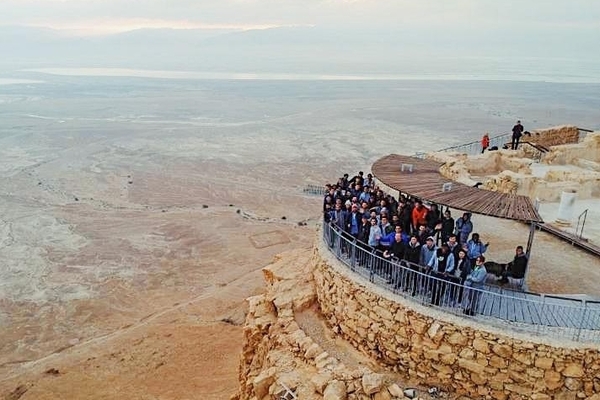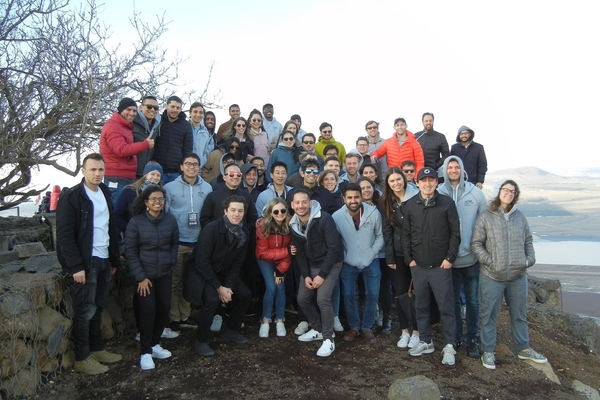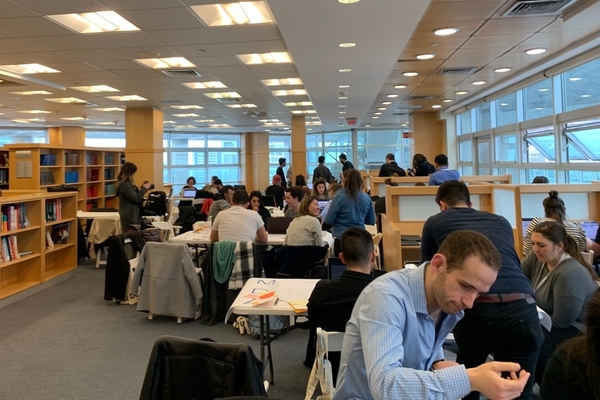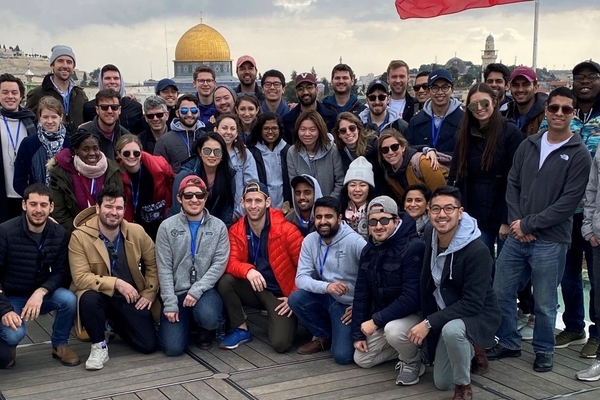Exploring history, culture, and health tech innovation in Israel

Participants in Cornell Tech’s iTrek to Israel take a morning hike to Masada
Cornell Tech’s iTrek event joined together 52 MBA, law, and engineering students for a 10-day trip to Israel. From historical site visits to hackathon challenges, we discovered the entrepreneurial spirit that drives the nation, learned about the growing economy of innovation, and broadened our view of Middle Eastern politics—all while, of course, having fun. As a
Geopolitics and a look at the Israeli Air Force
The trip started with an Air Force base visit near Haifa, where we learned about the northern border and watched fighter jets take off. We came at a sensitive time—only a couple days after the United States launched the drone strike that killed Iran’s top general. Visiting the Air Force base lent a sense of security to our stay, as we learned about Israel’s mandatory service for both men and women, the army’s cutting-edge technology, and its STEM degree programs post-service.

We then traveled to the Golan Heights, a rocky plateau in the northern border with political and strategic significance to both Syria and Israel. Israel seized the Golan Heights, a natural buffer against military offensives, from Syria during the Six-Day War in 1967. At the Golan Heights, we had the pleasure of listening to a talk by Miri Eisin, a retired colonel of the Israel Defense Force and a former international advisor to the Israeli prime minister. Eisin shed light on regional geopolitics in the Middle East, recent tensions between the United States and Iran, and different narratives around the Israeli-Palestinian conflict.
Innovating across health, tech, and business
One of the highlights of the trip was participating in a , which explored the future of healthcare through data, technology, design, and business strategy collaboration. The Sourasky Medical Center, the second largest hospital in Israel, would host the event, with each team assigned a challenge from the hospital or the World Health Organization (WHO). The topics included: emergency preparedness, reducing wait times, patient onboarding, health data storage, tracking and moving patients, emergency room care, and much more.
Throughout the hackathon, we were mentored by doctors and professors from the hospital and joined by students from the Technion – Israel Institute of Technology and designers from various technology companies. Based on the project prompt, each team had a special tour at the hospital, which included visiting the delivery room, observing doctors at the emergency room, or interviewing patients in the waiting room.

Our team’s project was to work with the WHO to create a solution for patients to carry their personalized health information that could be accessed at any and all times. After hours of discussion and hard work, we responded with a mobile app that enables patients to build, manage, and share health data. The app bears an emergency function by which doctors can access patients emergency dataset such as allergies, major surgeries, vaccination history, and emergency contacts with biometric verification, of significance for refugees in need of a mobile health database that is accessible even in the case of emergencies.
Jerusalem: History, conflicts, and the wall
Our team then walked to the desert, where we rode camels overlooking the sunset, enjoyed bonfires, hiked Masada toward sunrise, and floated on the dead sea. The most unforgettable part of the trip was the two-day visit to Jerusalem, one of the holiest places in the world, where we learned about the history and conflicts in the city. We spent the first night at a which told the story of Jerusalem through breathtaking, virtual reality images. The stones of the walls fade into the scenes and the screen images envelop the viewers, a multi-sensory experience sweeping through the history of a city destroyed twice, fought over 16 times, and recaptured 44 times.

We took a bus tour around East Jerusalem, too, where we learned about the complex and tangled situation between the Israelis and Palestinians. We visited the ancient ruins, Dome of the Rock, a vivacious market dating to the turn of the last millennium, and a wall along the mountains and next to the highways that separate Israel’s eastern border and the Palestinian-controlled West Bank. Israelis see it as protection, while Palestinians see it as an attempt to expel them from Jerusalem. Approximately 65,000 Palestinians cross the wall’s checkpoint every day.
I appreciated the opportunity to access this complexity, which was made possible for me by the support of the Emerging Markets Institute.

